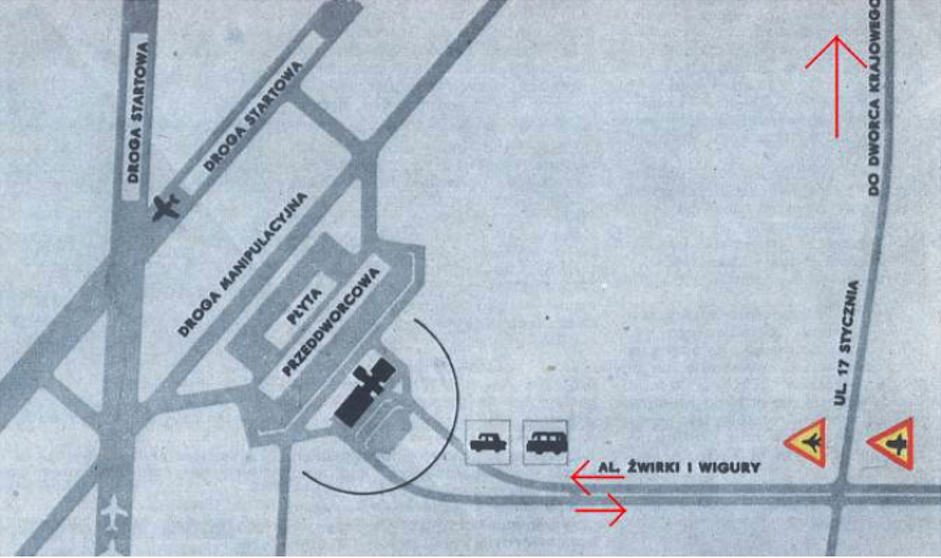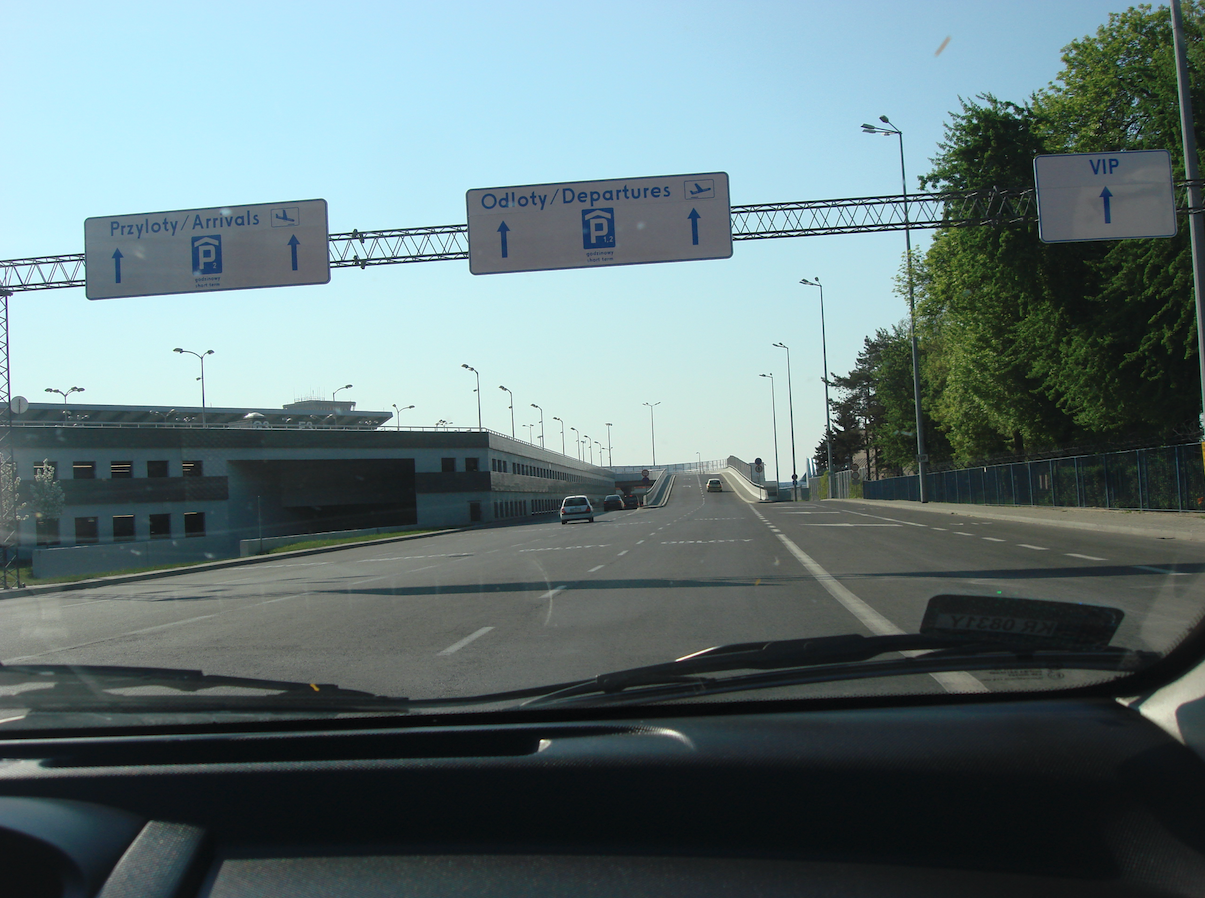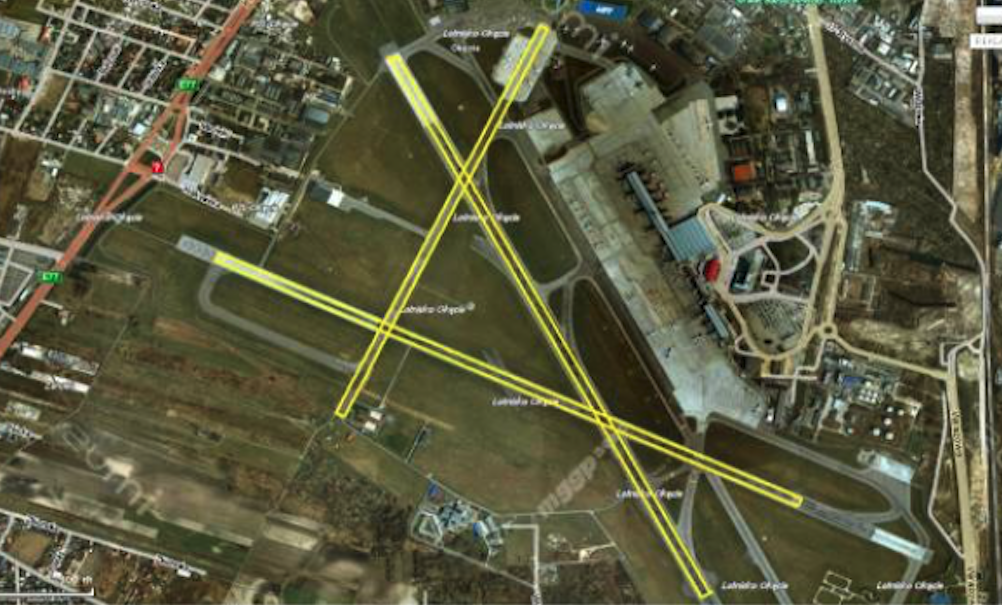Kraków 2010-02-01
Lotnisko Okęcie
Lotnisko Okęcie od 1945 roku do 1990 roku.
Kilka zdań o RWY (DS.) na Lotnisku Okęcie.
Kiedy w 1934 roku oddano do użytku Lotnisko Okęcie nie było utwardzonych dróg startowych. Pole wzlotów został zbudowane na kształt elipsy, według ówczesnych wzorów francuskich. Obszary przeznaczone do kołowania samolotów składały się z dwóch części. Pierwsza to betonowa płyta peronowa. Usytuowana była przed budynkami dworcowymi i sąsiadującymi obok hangarami. Na niej odbywała się cała obsługa samolotów i pasażerów. Już wówczas bagaże pasażerów dostarczała do samolotu służba lotniskowa na ręcznych wózkach. Poza płytą znajdowało się pole wzlotów. Pole wzlotów lotniska miało wymiary 1 270 m na osi północ-południe i 1 470 m wzdłuż osi wschód-zachód. Miało nawierzchnię gruntową, z systematycznie koszoną trawą. Masa samolotów nie była taka wielka, aby konieczne było dodatkowe utwardzanie pola wzlotów. W tamtych czasach start i lądowanie samolotów odbywała się dokładnie pod wiatr. Dlatego szykujący się do startu samolot kołował na skraj pola wzlotów na stronie zawietrznej. Tam ustawiał się przodem do wiatru i wykonywał start. Był to wówczas światowy standard.
Zbudowano trzy utwardzone drogi startowe. Niestety, bardzo szybko okazało się, że DS. (RWY) na kierunku 03/21 nie może być użytkowana. Na jej przedłużeniu z jednej strony powstał maszt w Raszynie, a z drugiej w centrum Warszawy Pałac Kultury i Nauki. Tak lotnisko pozostało z dwiema DS. (RWY), które w ciągu kolejnych lat wydłużono, poszerzono i zwiększono ich nośność. DS. (RWY) na kierunku 03/21 do dnia dzisiejszego pełni rolę DK.
Lotnisko Okęcie w czasach PRL.
Po drugiej wojnie światowej Okęcie przez długie lata pozostawało w znikomym procencie odbudowane, a odprawy pasażerów odbywały się w prowizorycznie przystosowanych budynkach, mieszczących się przy ulicy 17 Stycznia. Praktycznie nie zachowały się żadne zdjęcia z tego okresu. Nie ma się co temu dziwić. W PRL każdy posiadający aparat fotograficzny, np. Druch, był potencjalny szpiegiem. Najbezpieczniejsze zdjęcia były robione w atelier do Dowodu Osobistego i w ZOO.
Co było tego powodem? Możemy napisać krótko – rządy komunistyczne. Ale to jest pójście na skróty. Po pierwsze. Loty pasażerskie uznawano na Wschodzie za imperialistyczną wygodę. Po drugie. Rosjanie podjęli decyzję o budowie wielkiego lotniska wojskowego na terenie Bemowa. To na tamtym lotnisku lądowały samoloty z delegacjami z zagranicy. To tam demonstrowano radzieckie „cuda techniki”, jak na przykład samolot Tupolew Tu-104, który aby wylądować na Lotnisku Bemowo musiał użyć spadochronów hamujących.
Pasażerowie dowożeni byli ciężarówką, bo produkcji autobusów jeszcze nie uruchomiono. Za płotem stoją dwa myśliwce Spitfire, którymi wrócili z Anglii do kraju piloci Dywizjonu 302 i 317. Po kilku latach samoloty te pocięto i zniszczono siekierami. Lotnisko Okęcie 1946 rok.
Pierwszy po wojnie, dworzec lotniczy był więcej niż spartański. Zlokalizowano go w północnej części lotniska przy ulicy 17 Stycznia. Po otwarciu w 1969 roku, MDL (Międzynarodowego Dworca Lotniczego) zaczął pełnić tylko funkcje Dworca Krajowego. Wszyscy odlatujący do Polskich miast korzystali z tego dworca przez długie dziesięciolecia, do końca 80-tych lat.
W maju 1951 roku, nastąpiło włączenie miasta Włochy i gminy Okęcie do miasta Warszawy. Stały się one częścią składową Dzielnicy Warszawa-Ochota, która została wówczas wyodrębniona, jako samodzielna jednostka administracyjno-gospodarcza.
W 1994 roku, w wyniku nowego podziału administracyjnego miasta, Okęcie stało się częścią składową gminy Warszawa-Włochy. Zmiany zarówno przynależności administracyjnej jak i włączenie Okęcia do miasta Warszawy miały znaczny wpływ na rozwój gospodarczy i szkolnictwa na tym terenie, spowodowany wzrostem liczby mieszkańców.
Dworzec lotniczy z 1969 roku.
Do budowy nowego dworca lotniczego szykowano się niemal od 1945 roku, ale zawsze szło po grudzie. Z końcem 50-tych lat XX wieku wykonano kolejne analizy i konieczność wybudowania nowego dworca okazywała się wręcz niezbędna. Analiza ta została wykorzystana przez Zarząd Główny Stowarzyszenia Architektów Polskich i w 1960 roku, zorganizowano konkurs na projekt Międzynarodowego Dworca Lotniczego (MDL). Zwycięzcą konkursu okazał się projekt magistrów inżynierów Krystyny i Jana Dobrowolskich. Koniecznym okazało się nie tylko pobudowanie MDL, ale rozbudowa wszystkich obiektów Centralnego Portu Lotniczego Warszawa-Okęcie. Powoli do świadomości władz docierała informacja, że Lotnisko Okęcie to ma być wizytówka Polski, Polski Socjalistycznej. „Gdzie ludziom żyje się dostatnio”.
Po długich miesiącach Partia dała zielone światło i w Warszawskim Biurze Studiów i Projektów Transportu Drogowego i Lotniczego przystąpiono do wykonania projektu technicznego. Kierownikiem zespołu technicznego został magister inżynier Dariusz Rogowski. Konstrukcję budynku zaprojektowali; Aleksander Włodarz, Czesław Cywiński, Witold Jędrzejewski i Tadeusz Tesarski. Przy tak nietypowym budynku mocno się napracowali.
Dopiero w 1964 roku, przystąpiono do budowy MDL. Dworca z prawdziwego zdarzenia. Na miarę tego z 1934 roku, oczywiście w nowej skali. Pod koniec panowania nieudolnego Władysława Gomułki, po pięciu latach budowy, w dniu 27 kwietnia 1969 roku, otwarto nowy dworzec lotniczy wraz z wieżą kontroli lotów, zwaną grzybkiem i słynnym tarasem widokowym.

Sam dworzec był przestronny i się podobał. Szczególny zachwyt wzbudzał sufit; przestrzenny, graniastosłupowy, jakby kryształowy. Znakomicie dopełniał całość i nic dziwnego, że to on był eksponowany niemal na wszystkich zdjęciach. Doskonale prezentował się wewnątrz jak i na zdjęciach lotniczych. Szkoda tylko, że były usterki w wykonaniu dachu i lokalnie przeciekał. Obiekt tak się spodobał partyjnym kolegom, że zdecydowali się wyróżnić go nagrodą państwową. Dostrzeżony również z uznaniem, z racji swej architektury i konstrukcji, przez przedstawicieli zagranicznych linii lotniczych i przybywających do Polski zagranicznych pasażerów.
Taras widokowy był niezwykle prostą, ale bardzo atrakcyjną budowlą. Jego całkowita długość wynosiła 230 m. To z niego żegnano odlatujących i witano przylatujących bliskich i znajomych. Było to także miejsce rodzinnych i szkolnych wycieczek, nie tylko warszawiaków. Taras ten stał się miejscem wielu scen w Polskich Filmach.
Nowoczesnym obiektem była wieża kontroli. Nie tak wysoka jak ta z 1934 roku, ale swoje zadanie wypełniała znakomicie. Z niej obsługiwano ruch samolotów na płycie peronowej. Pod wieżą był tak zwany domek pilota. W 70-latach, Lotnisko Okęcie prezentował się dobrze. Wraz z otwarciem nowego dworca uruchomiono linię autobusową nr 175, który kursuje do dnia dzisiejszego (2009 rok).
Dworzec był użytkowany do 1992 roku, kiedy to otwarto nowy dworzec zwany już terminalem, a dokładnie Terminal 1. Dalsza gospodarka przestrzenna inwestora doprowadziła do powstania zagranicznych pawilonów, jak fińskiego, a później niemieckiego. W efekcie dworzec z 1969 roku, został rozebrany w 1998 roku.
Opracował Karol Placha Hetman


